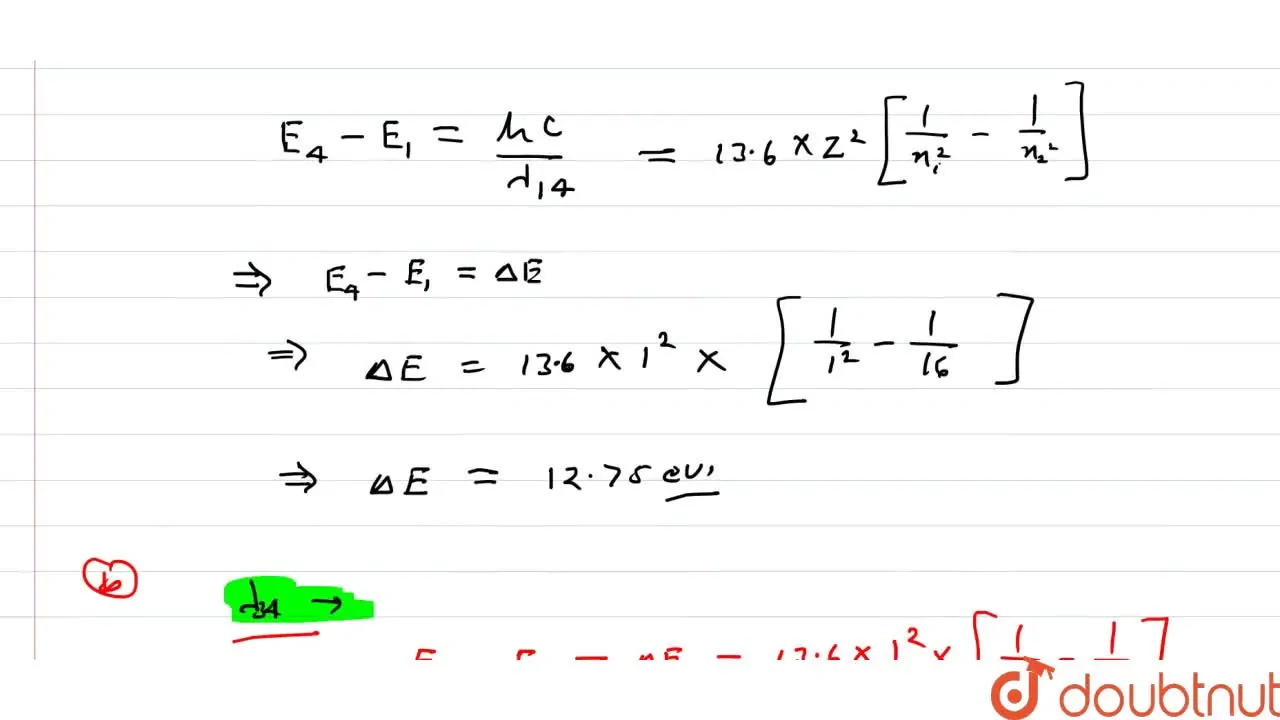A hydrogen atom is in the third excited state. It make a transition to a different state and a photon is either observed or emitted. Determine the quantum number n of the final state and the energy energy of the photon If it is
a emitted with the shortest possible wavelength.
b emitted with the longest possible wavelength and
c absorbed with the longest possible wavelength.
When a photon is emitted , it carries energy with it , so the final energy of the atom is less than the initial when a photon is emitted.
An atom gains energy when a photon is obsorbed. So the final quantum number is greater than the initial when a photon is obsorbed.
The largest possible energy arised when the electron jumps from the initial state (n=4) to the ground state (n1=1) as shown by transition A in the figure . Therefore the quantum number of final state is n=1. The energy of the nth state is given by
En=(Z2n2)

The energy of the photon emitted corresponding to transition from excited state quantum number nu to lower energy state n1 can be calculated from
hcλ=E_(u)−E1=(13.6)(1)2[1n21−1n2u] So ,the energy of the poton with minimum wevelength is
ΔE=E4−E1
=(13.6)(1)2(112−142)=12.75eV
b. The longest possible wevelength photon corresponds to minimumn energy . This happens when the electron jump from the initial state (nu=4) to the next lower state (n1=3) as shown by transition B in the figure. Therefore , the quantum number of the final state is n=3. The energy of the photon is
ΔE=E4−E3=(13.6)(1)2(132−142)=0.661eV
c. The absorbed photon has the longest possible wavelength when its energy is the smallest , i.e., the electron jump from the initial state (n1=4) to the next higher state (nu=5) this is shown by transition C in the figure. Therefore , the quantum number of the final state is n=5. The energy of the photon is
ΔE=E5−E4=(13.6)(1)2(142−152)=0.306eV
Related Playlists
- BOOK - CENGAGE PHYSICSCHAPTER - ATOMIC PHYSICSEXERCISE - Solved Examples23videos
ATOMIC PHYSICS
- BOOK - CENGAGE PHYSICSCHAPTER - ATOMIC PHYSICSEXERCISE - Exercise 4.115videos
ATOMIC PHYSICS
- BOOK - CENGAGE PHYSICSCHAPTER - ALTERNATING CURRENTEXERCISE - QUESTION BANK65videos
ALTERNATING CURRENT
- BOOK - CENGAGE PHYSICSCHAPTER - ATOMSEXERCISE - QUESTION BANK40videos
ATOMS
Similar Questions
A hydrogen atom is in the third excited state. It make a transition to a different state and a photon is either observed or emitted. Determine the quantum number n of the final state and the energy energy of the photon If it is
a emitted with the shortest possible wavelength.
b emitted with the longest possible wavelength and
c absorbed with the longest possible wavelength.View SolutionA hydrogen atom is in a state of ionization energy 0.85 eV. If it makes a transition to the ground state, what is the energy of the emitted photon.
View SolutionA hydrogen atom in a having a binding of 0.85eVmakes transition to a state with excited energy 10.2eV(a) identify the quantum number n of theupper and the lower energy state involved in the transition (b) Find the wavelength of the emitted radiation
View SolutionA hydrogen atom (ionisation potential 13.6eV) makes a transition from third excited state to first excied state. The enegry of the photon emitted in the process is
View SolutionHydrogen atom from excited state comes to the ground state by emitting a photon of wavelength λ. If R is the Rydberg constant, then the principal quantum number n of the excited state is
View SolutionAn excited hydrogen atom emits a photon of wavelength λ in returning to the ground state. If R is the Rydberg constant, then the quantum number n of the excited state is
View SolutionAn excited hydrogen atom emits a photon of wavelength λ in returning to the ground state. If 'R' is the Rydberg's constant, then the quantum number 'n' of the excited state is:
View SolutionFind the quantum number n corresponding to nth excited state of He++ ion if on transition to the ground state the ion emits two photons in succession with wavelength 108.5 nm and 30.4 nm. The ionization energy of the hydrogen atom is 13.6 eV.
View SolutionA hydrogen atom, initially at rest in the n = 3 quantum state, undergoes a transition to the ground state, emitting a photon in the process. What is the speed of the recoiling hydrogen atom?
View SolutionHydrogen atoms is a particular excited state 'n', when all returned to ground state, 6 different photons are emitted.Which of the following is/are incorrect .
View Solution


